
1700-1775 NYC: Metropolitan Progress: Setting the Stage for American Independence
The 18th century marked a pivotal era in the history of New York City, highlighting its transformation from a modest Dutch settlement to an emerging urban powerhouse. This period was characterized by significant historical milestones, including the city’s critical role in the American Revolution, which profoundly influenced its developmental trajectory. The era laid the foundation for New York City’s evolution, setting the stage for its future prominence on both a national and global scale.
During this time, New York City began to establish itself as a major port, capitalizing on its strategic geographic location. The initiation of essential infrastructure and the early stages of street planning were crucial in paving the way for the city’s expansion. Notably, landmarks like Wall Street started to emerge, symbolizing the burgeoning economic strength that would become synonymous with the city’s identity.
Culturally, the 1700s saw New York City becoming a melting pot of diversity, with the influx of various ethnic groups contributing to the rich tapestry of its cultural landscape. This era of transformation brought about a dynamic mix of communities, each adding its unique flavor to the city’s complex identity. Despite facing numerous challenges, including the tumultuous struggle for independence, the city’s cultural evolution continued to thrive, laying the groundwork for its modern, cosmopolitan character.
In conclusion, the 1700s were a period of profound change and growth for New York City. The advancements in infrastructure, the flourishing of cultural diversity, and significant political developments during this century played a crucial role in shaping the city’s future. The legacy of this era, with its historical depth and cultural richness, remains an integral part of New York City’s narrative, underscoring its transformation into a vibrant metropolis and a beacon of urban development.
Timeline of New York City’s History 1700-1775
Discover surprising historical facts about The City That Never Sleeps—explore fun, educational insights into its history, population, iconic landmarks, and more, perfect for students, history enthusiasts, and anyone curious about NYC’s rich heritage.
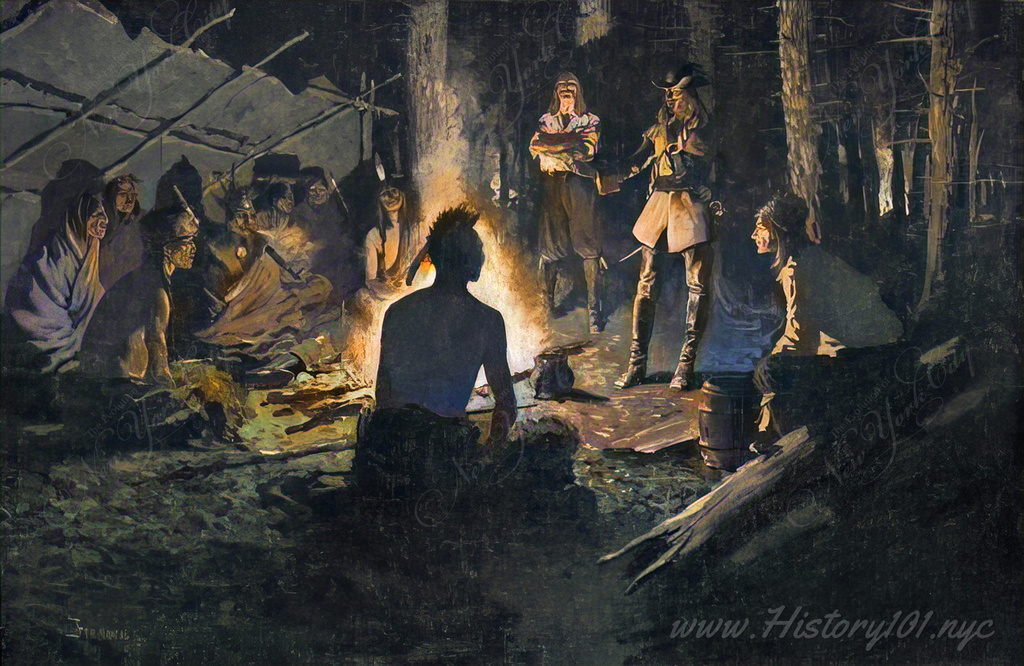
1700: The Iriquois Council Fire
This painting, titled "At the Iroquois council fire," is a visual representation of Native American life in the 1700s in the northern East Coast.
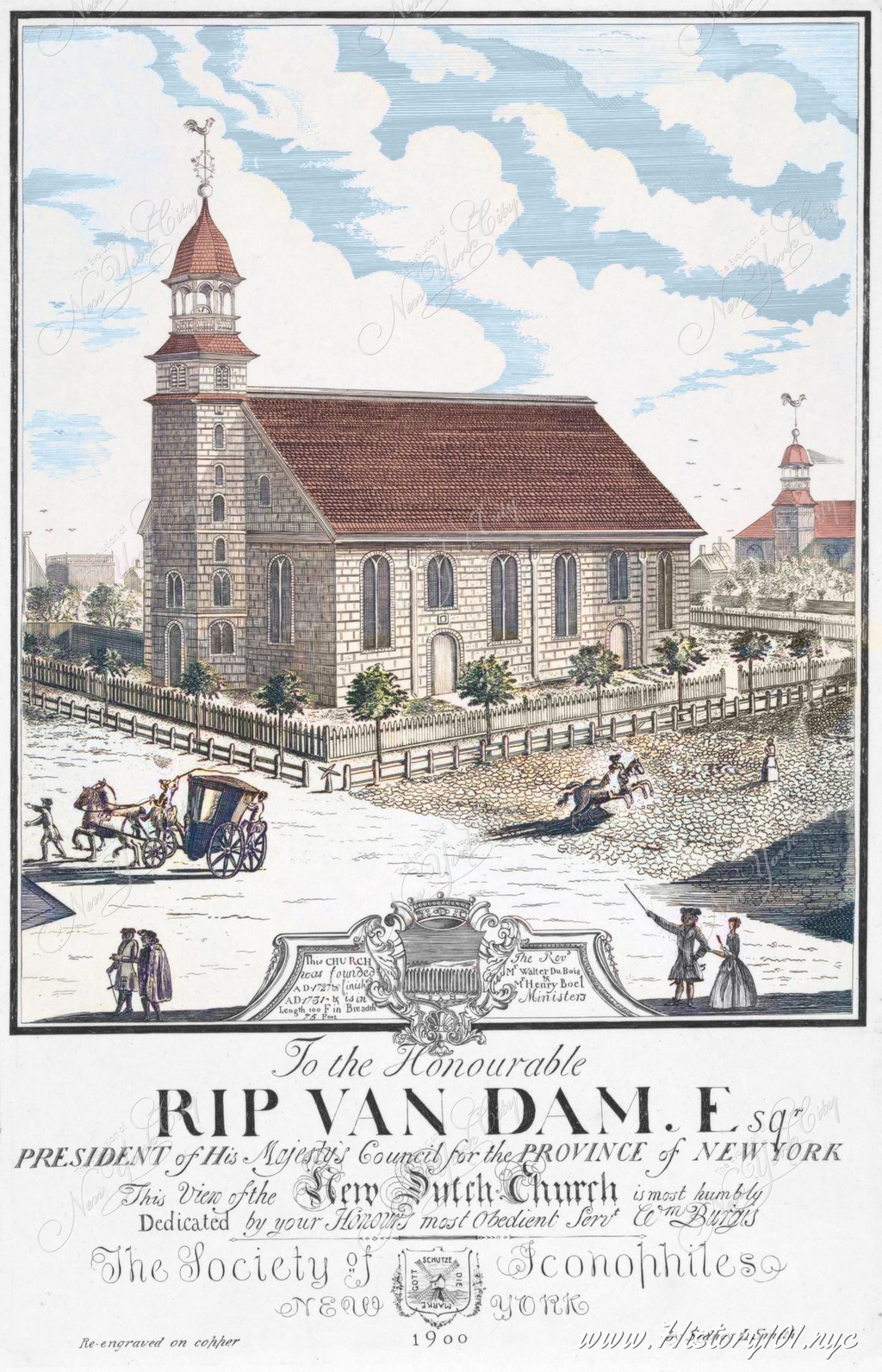
1731: Sidney Lawton Smith's Art: Capturing New York City's Dutch Era
Explore Sidney L. Smith's engravings, interpreting New York's Dutch era, especially the iconic New Dutch Church. A blend of art and history
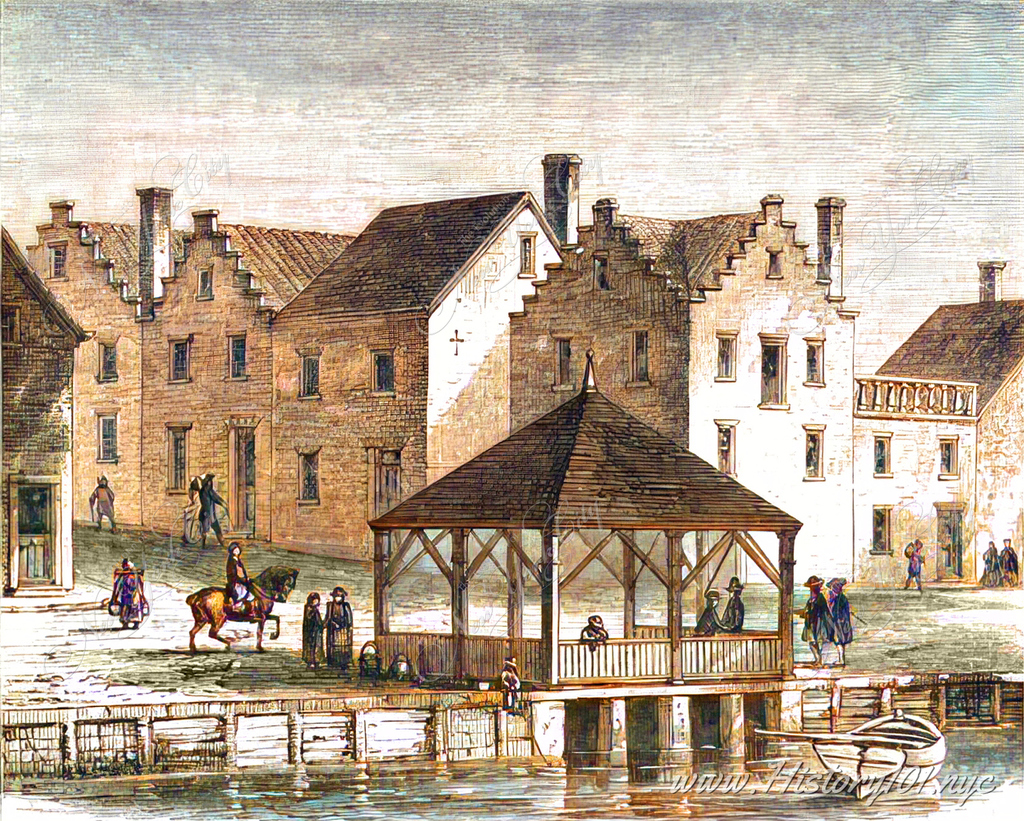
1746: The Ferry House - The Economic and Social Hub at Wall Street's Foot
Explore the bustling 1746 hub at the Foot of Wall Street, pivotal for New York's trade, transportation, and social vibrancy
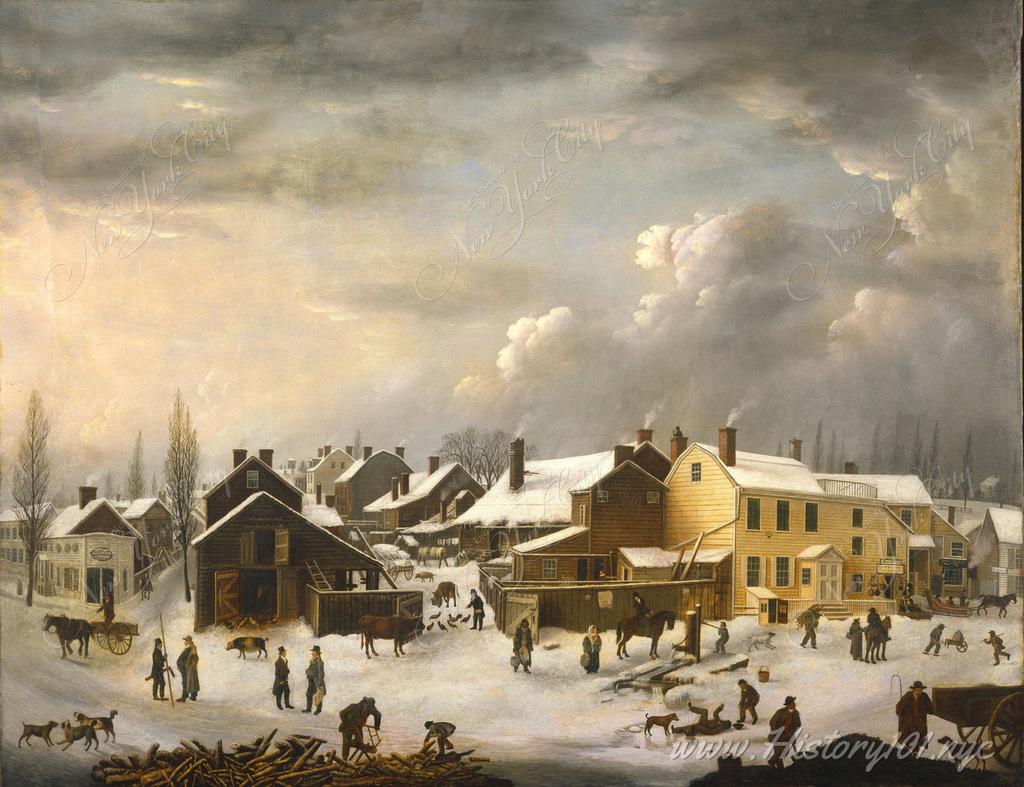
1760: Francis Guy's Brooklyn Winter Scene: NYC's Historical Snowscape
Discover Francis Guy's 'Winter Scene in Brooklyn', capturing 1760s village life, pivotal in NYC's transformation from rural to urban
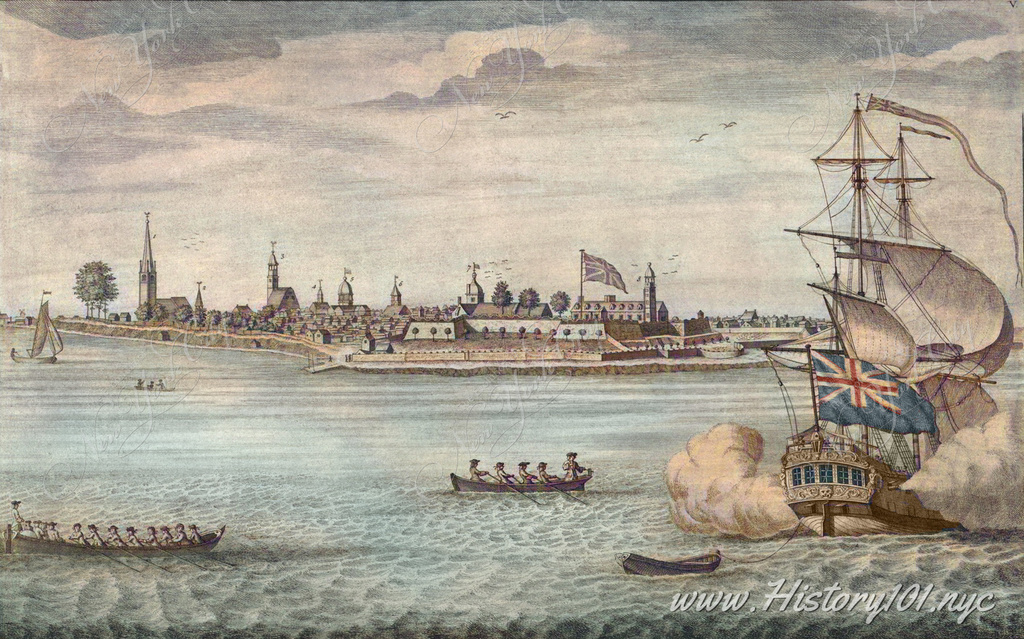
1763: View of Fort George from New York Harbor
This engraving by John Carwitham depicts a historical perspective of New York City in 1736. During this time, New York was a bustling colonial city with a rich tapestry of cultures and influences.
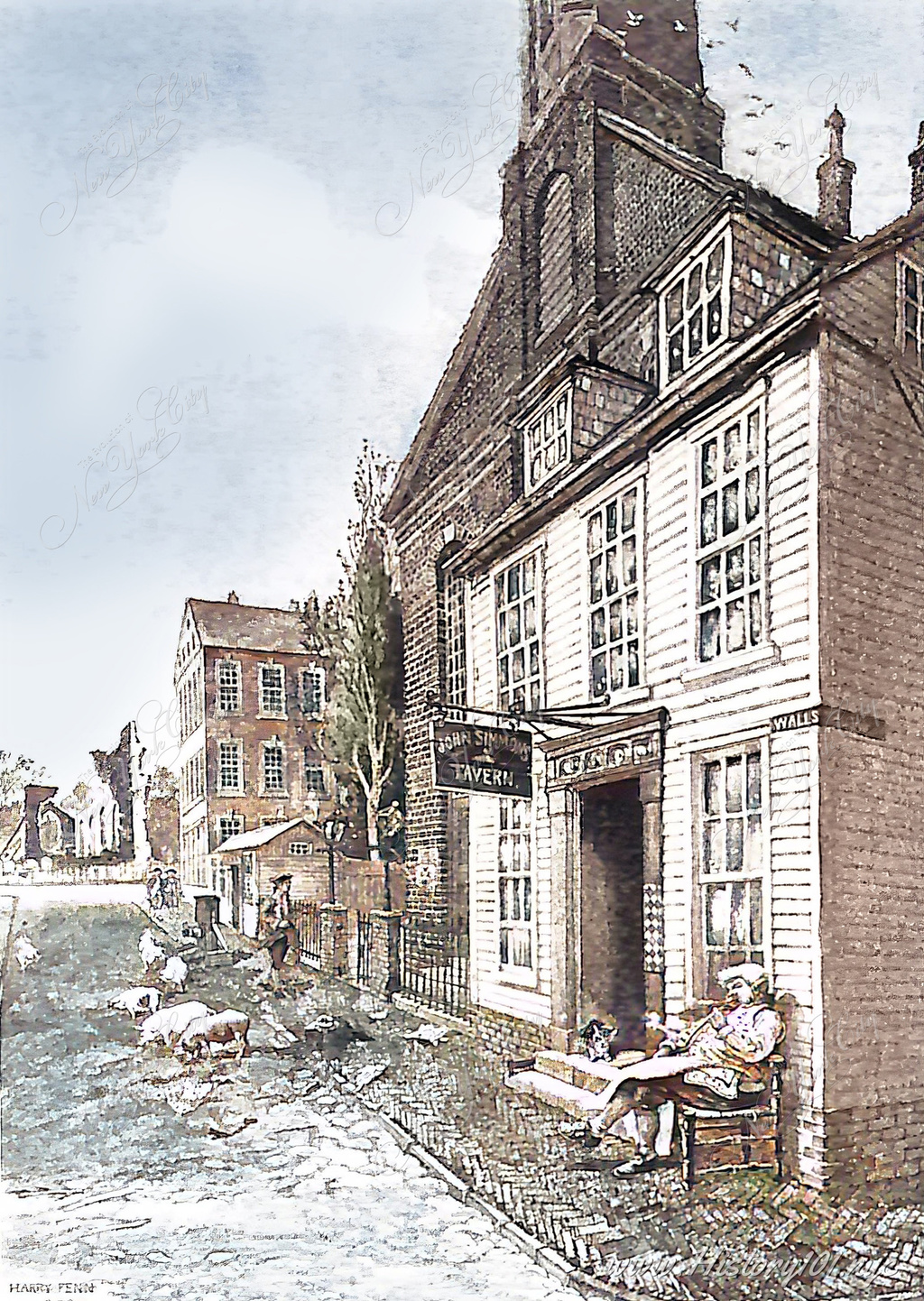
1764: Wall Street
This illustration depicts of John Simmons Tavern, located on Wall Street in New York City in 1764.
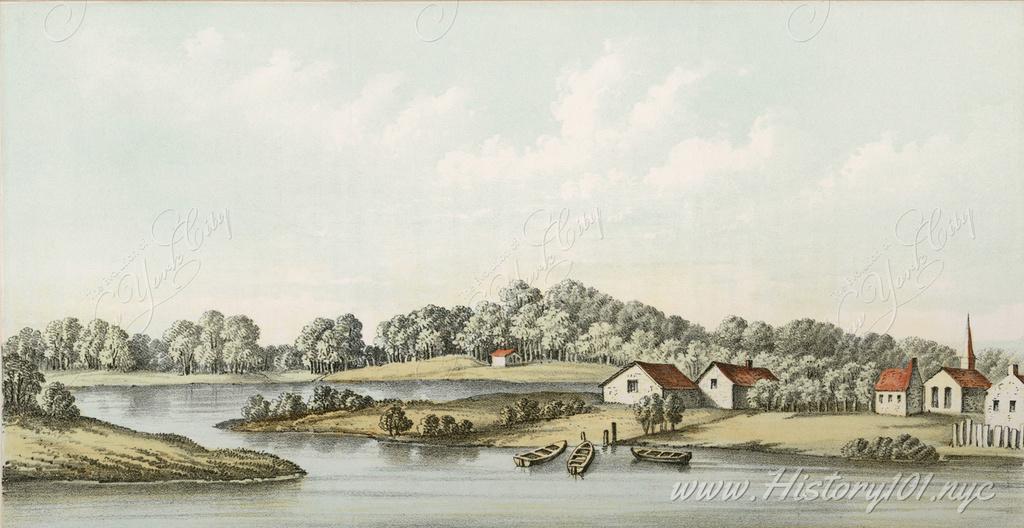
1765: View of Harlem from The Bronx: A Glimpse into Historical NYC
Discover the 1765 painting 'View of Harlaem from Morisania', depicting Harlem's historical landscape from the Bronx's perspective
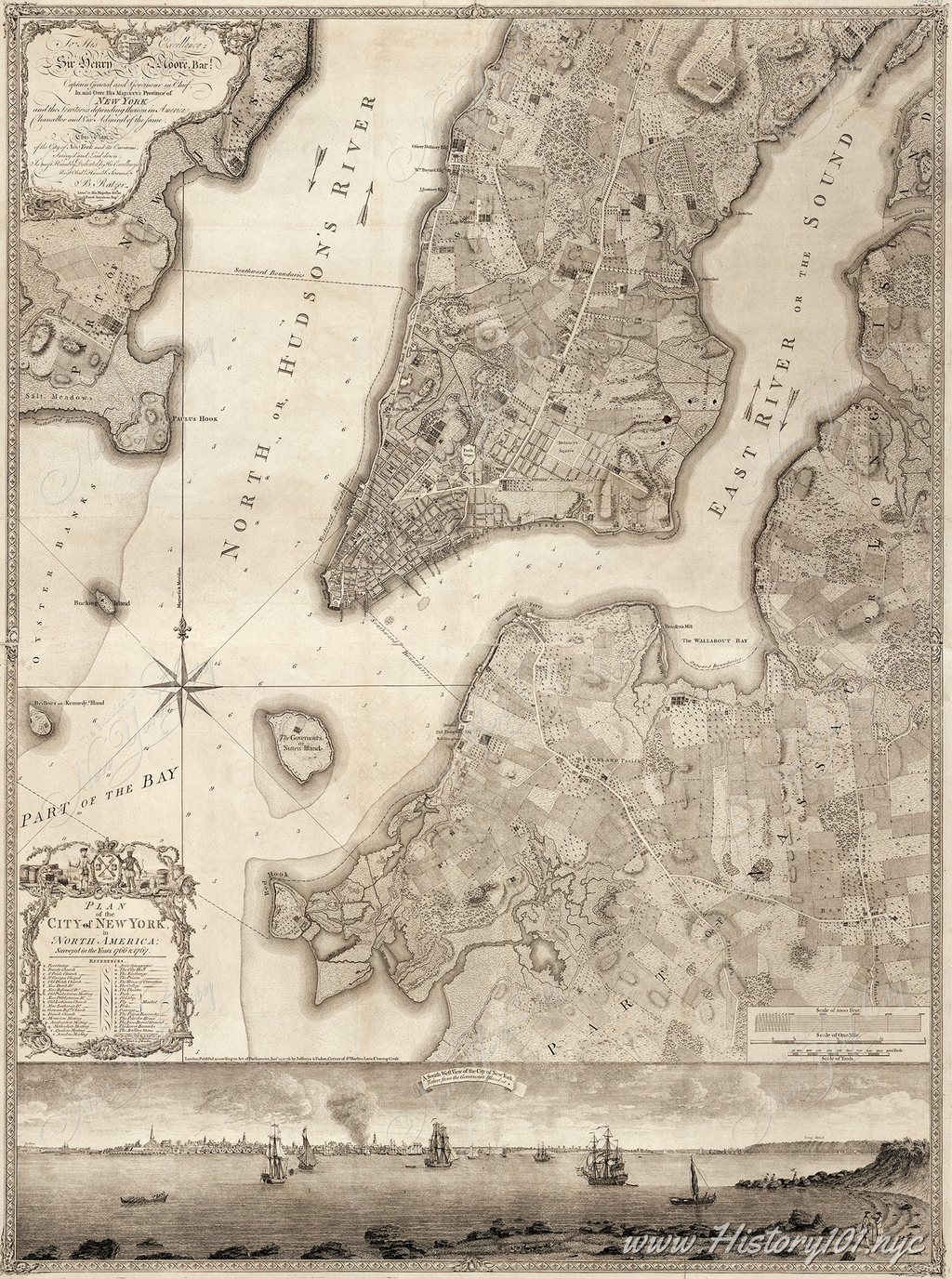
1766: Bernard Ratzer's New York Map: A Precise Pre-Revolutionary City Glimpse
Explore the 1766-1767 "Plan of the city of New York" by Bernard Ratzer, a detailed map capturing New York City's landscape before the American Revolution
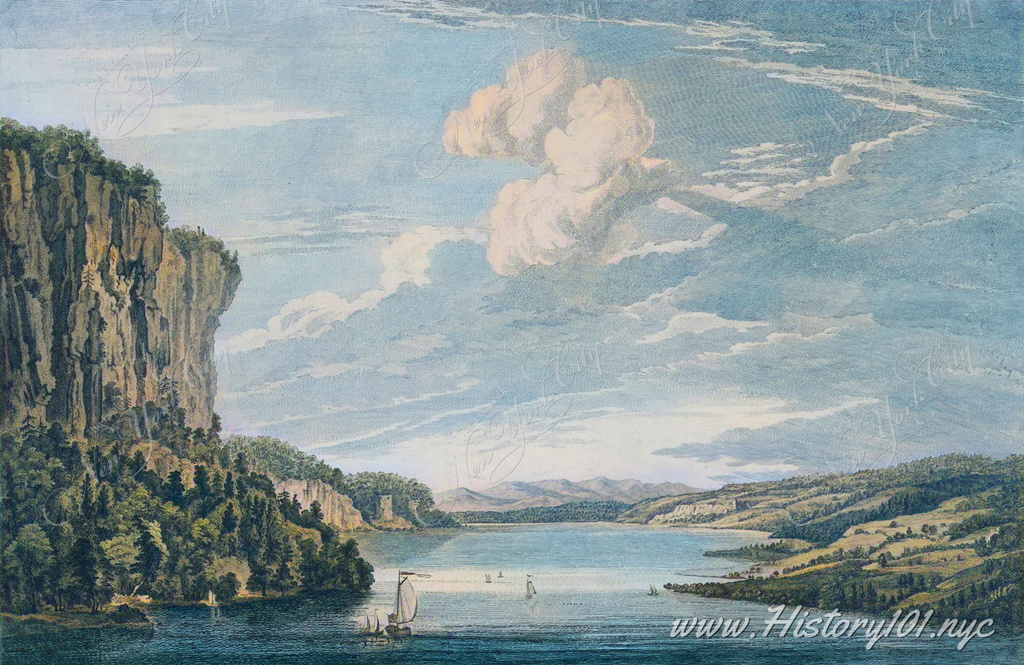
1768: The Hudson River and the Topan Sea
The image from 1768 captures a picturesque view in Hudson's River of the entrance to what is known as the Topan Sea, showcasing a serene waterscape with a ship and boats.
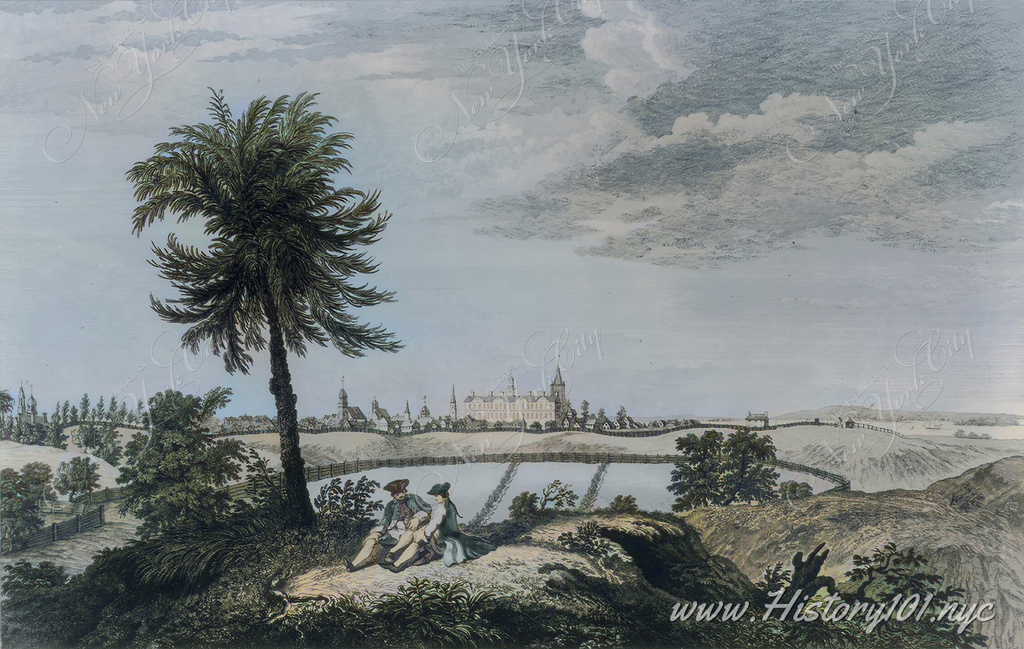
1768: South East View New York City
This image, titled "A south east view of the city of New York, in North America" dates back to 1768 and offers a glimpse at NYC during the late 18th century.
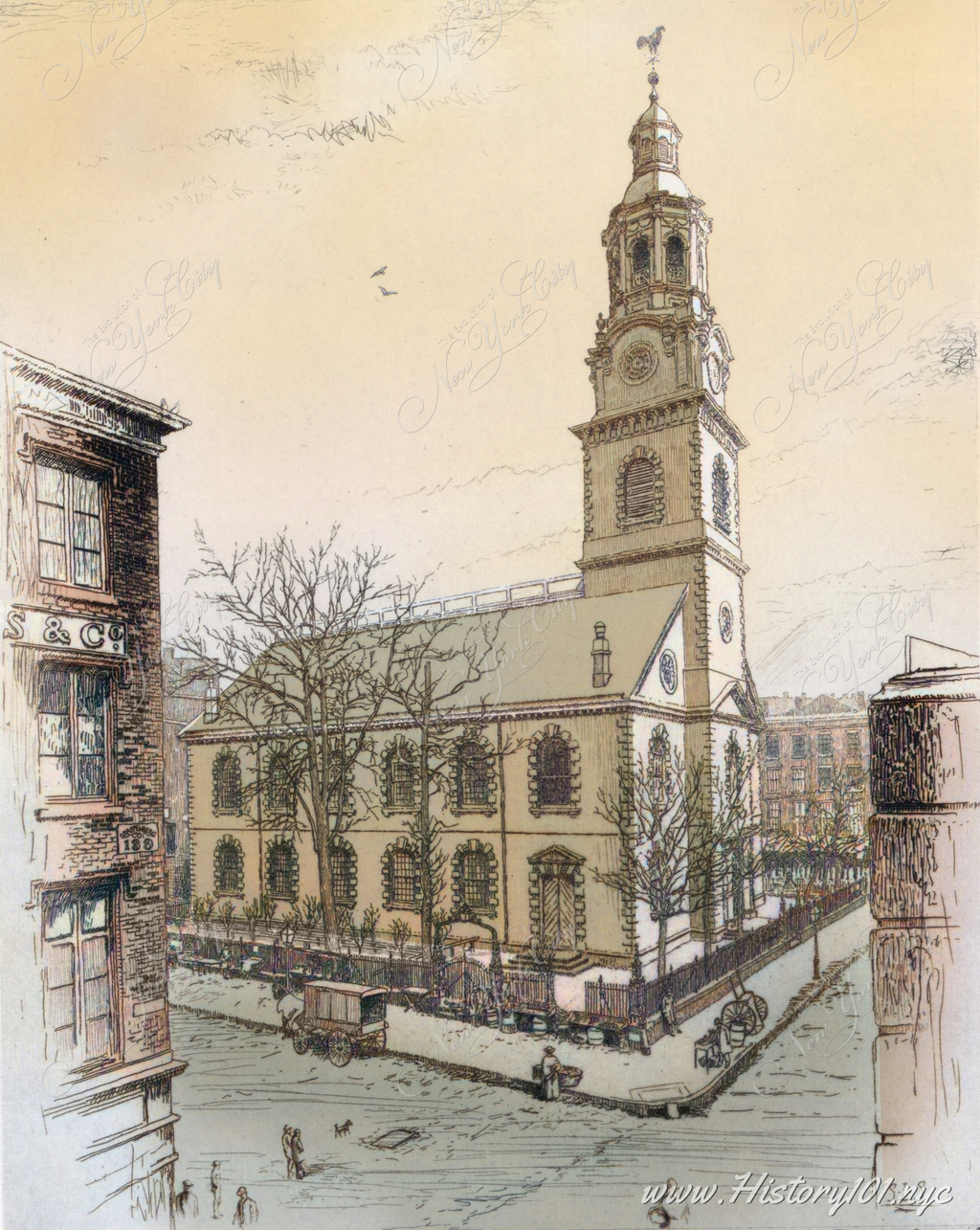
1769: North Dutch Church
This etching, created by Sidney Lawton Smith from a photograph depicts the North Dutch Church, a historical landmark in New York City
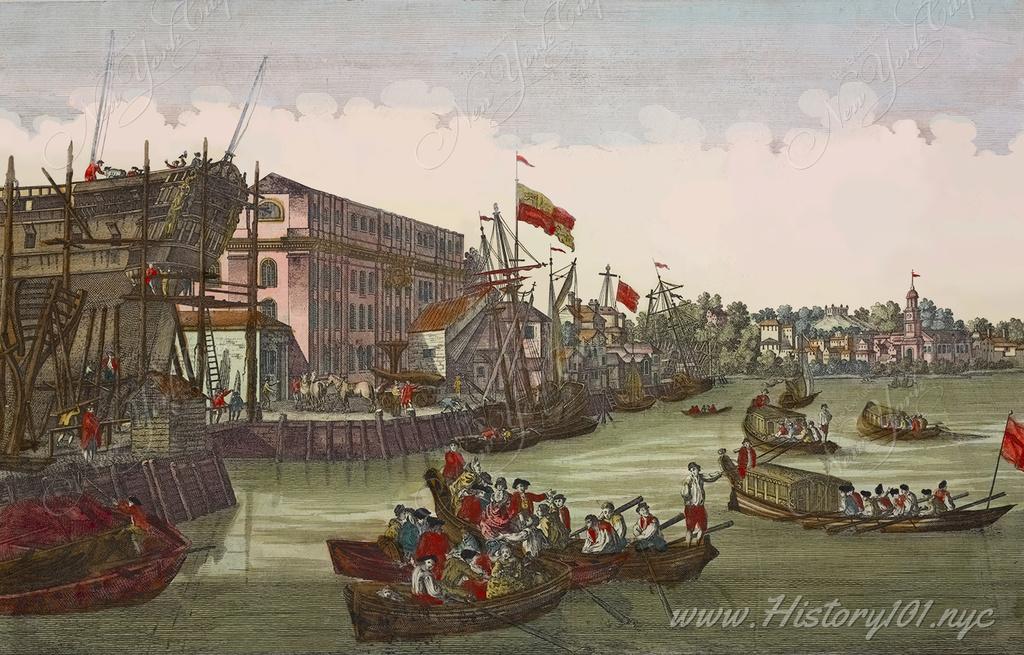
1775: NYC Harbor Engraving: A Glimpse into Maritime Commerce
Discover Leizelt's 1775 engraving of NYC harbor, a testament to the city's early role in shaping global maritime trade and commerce
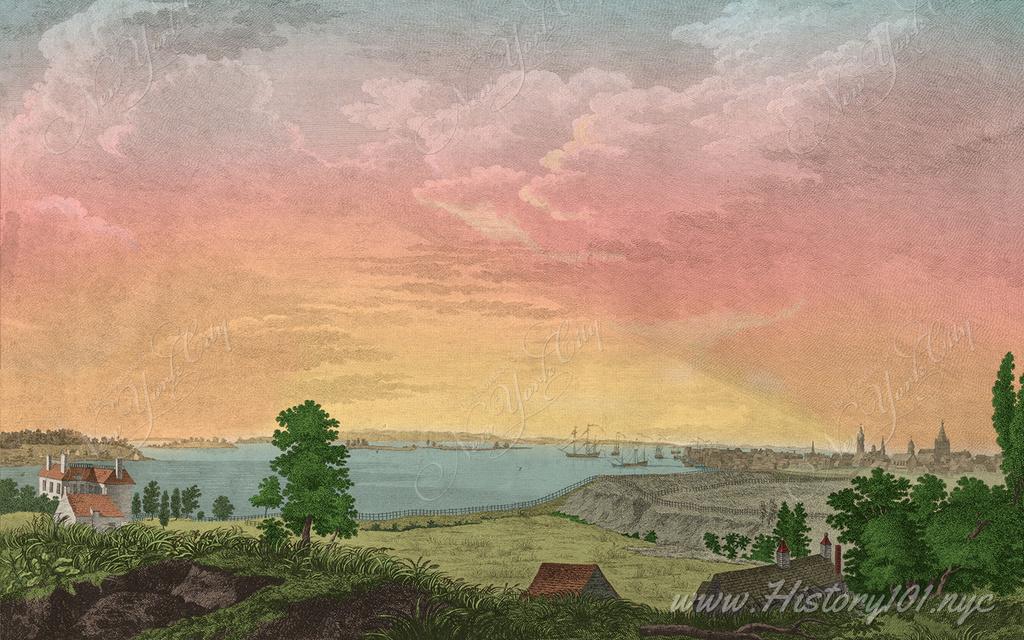
1775: Revolutionary New York: Howdell's Art & Canot's Engraving
Explore 'A south west view of New York', a historic artwork capturing the city during the Revolutionary War, created by Howdell and engraved by Canot
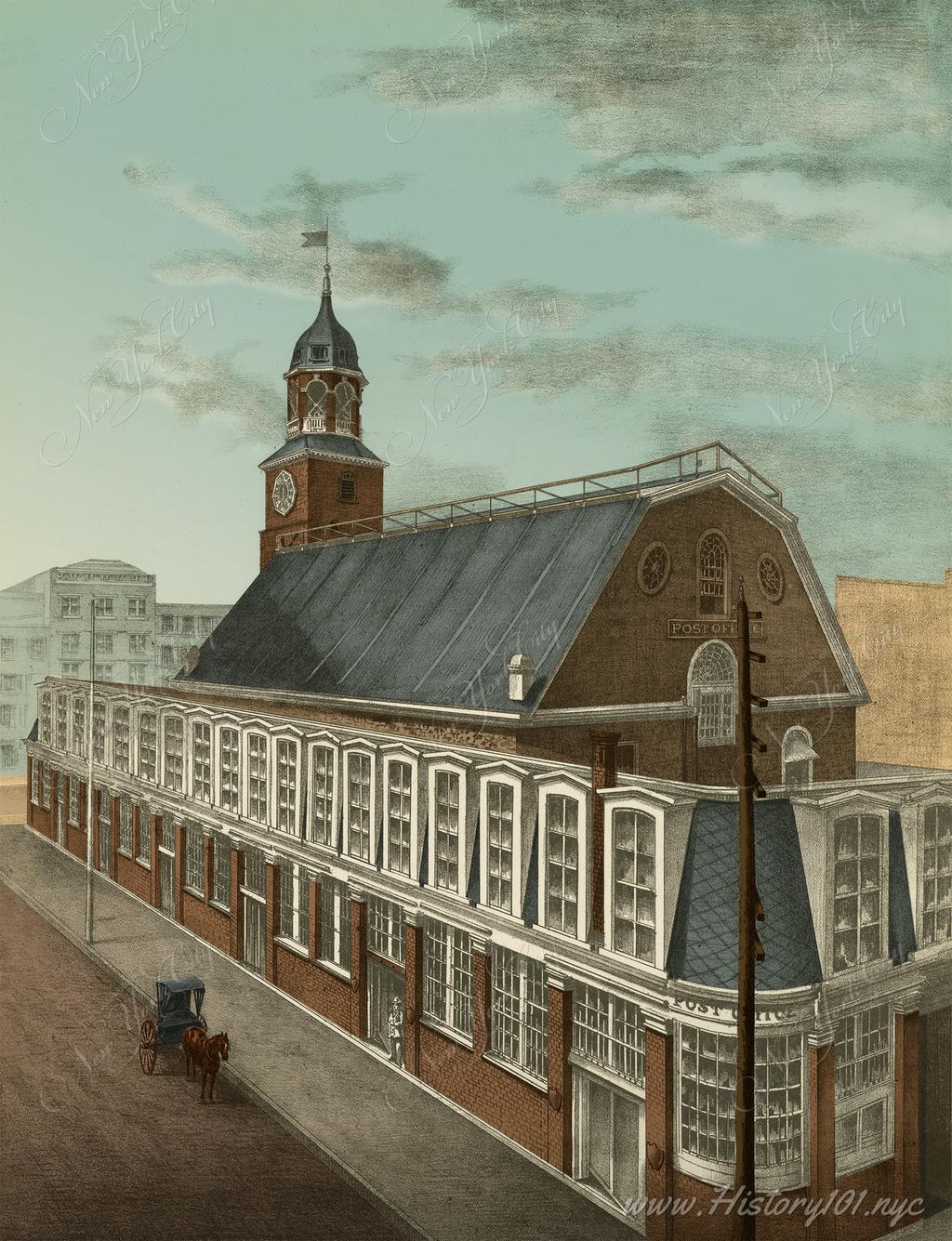
1775: The Dawn of U.S. Postal Service and NYC's Pivotal Role in The American Revolution
Explore the birth of the U.S. postal system in 1775, Franklin's role, and NYC's critical impact on commerce and politics during the American Revolution
Timeline of New York City: 1700-1775
1700: The settlement formerly known as New Amsterdam had an estimated population of about 5,000, reflecting both its Dutch origins and transition to English governance. The diverse cultural tapestry included Dutch, English, African, and Native American communities, each contributing unique languages, traditions, and customs. This blend of backgrounds strongly influenced local commerce, governance, and social practices. Situated at the southern end of Manhattan Island, the settlement benefited from its accessible waterways, facilitating trade and communication among different powers. These early developments laid the groundwork for the city’s future, foreshadowing the vibrant, multicultural metropolis it would soon become.
Strategically located at the mouth of the Hudson River, New York City benefited immensely from its advantageous position for trade and commerce. By the late 1700s, the urban population, though still far below hundreds of thousands, steadily advanced due to expanding mercantile opportunities. Maritime routes stimulated a flow of newcomers, amplifying the city’s cultural tapestry and economic scope. This gradual but consistent growth reinforced its significance in regional politics, cultural expression, and early American innovation. As the century progressed, New York City built upon the foundation set by diverse settlers, foreshadowing the global metropolis it would eventually become in the decades ahead.
1703: Construction commenced in 1700 on a significant structure at 26 Wall Street, which was destined to become an integral part of New York City's architectural and civic landscape. Completed in 1703, this building initially served as the city's second city hall. Over time, its role expanded dramatically, especially following the American Revolution, when it was transformed into Federal Hall. This iconic venue marked a new chapter in American history, notably serving as the site of George Washington's inauguration as the first President of the United States in 1789. It also hosted the first sessions of the U.S. Congress, further cementing its place in the nation's historical narrative.
The original building was demolished in 1812, but the site retained its great historical significance. A new Federal Hall was erected on the same location, evolving through various uses from a Custom House to its current role as a museum and memorial. This transformation reflects the building’s enduring importance and encapsulates its profound role in American history. Today, Federal Hall stands not only as a tribute to the past events that shaped the United States but also as a symbol of the enduring principles of democracy and governance that were pioneered on this very site.
1704: Elias Neau, a French Huguenot and Society for the Propagation of the Gospel (SPG) member, initiated a notable religious and educational mission in New York City, focusing on ministering to enslaved African-Americans. His SPG-sponsored work provided religious instruction and catechism, representing one of North America's earliest organized attempts at educating African-Americans in the Anglican tradition.
Neau's curriculum combined religious teachings with basic literacy, a groundbreaking approach when educational opportunities for African-Americans were scarce and often opposed. While primarily religious, this initiative marked an early form of schooling for African-Americans in the city. Elias Neau's contributions to the spiritual and educational life of early 18th-century enslaved Africans in New York City are a significant part of his legacy.
1709: Established by Trinity Church's parish, Trinity School is among New York City's oldest schools, originally serving as a charity institution for parish children and others. This founding showcased the church's dedication to education and community service.
Over centuries, Trinity School has evolved significantly, mirroring New York City's educational progression. Starting as a modest charity school, it expanded and adapted to ongoing educational demands. Its establishment in the early 18th century and sustained presence for over three centuries underscore its pivotal role in the city's educational history and the development of its academic landscape.
1711: New York City marked a somber historical moment with the establishment of a slave market on Wall Street's eastern end, near the East River. Sanctioned by the Common Council, this market was pivotal in the city's economy and society, primarily dealing in the sale and rental of enslaved Africans and Native Americans.
Operating for decades, the Wall Street slave market was central to slave transactions in the city, catering to various labor needs like domestic work, construction, and shipping. This market not only underscores New York City's role in the transatlantic slave trade and dependence on slave labor but also serves as a poignant reminder of the city's historical ties to slavery, reflecting a significant yet dark chapter in colonial America's narrative.
1712: In New York, where large plantations were absent, enslaved Africans often held skilled positions like carpentry and masonry. Despite their skills, tensions culminated on April 6, 1712, when a group, estimated between 20 and 70, ignited a building, attacking settlers who responded, killing nine and injuring others.
The revolt was swiftly quashed, but led to severe repercussions: around 70 were arrested, 43 faced trial, with 25 convicted—20 hanged and three burned at the stake. This insurrection, starting on Maiden Lane, intensified slave laws, reflecting the stark desperation and resistance of the enslaved, profoundly affecting New York's legal stance on slavery and marking a pivotal moment in the struggle against oppressive conditions.
1714: Named after the House of Hanover during King George I's rise to the British throne, Hanover Square swiftly emerged as a pivotal commercial hub in New York City. It hosted significant institutions like the New York Cotton Exchange at 1 Hanover Square, crucial to the city's economic fabric.
The square's history was notably marked by the Great Fire of New York on December 16, 1835, which ravaged Lower Manhattan. Over time, Hanover Square evolved, with key structures such as the Cotton Exchange and 10 Hanover Square transitioning from commercial to residential spaces, exemplifying the dynamic adaptability of New York's urban environment.
1723: New York City's population had grown to approximately 7,248, reflecting its evolution from a Dutch outpost to a major urban center in the American colonies. This growth was driven by its strategic port location, diverse economic opportunities, and a mixed population of European immigrants, enslaved Africans, and native-born individuals.
This demographic diversity fueled the city's trade and commerce, underscoring its growing importance in North America's landscape. The 1723 population figure, a milestone in the city's early 18th-century expansion, foreshadowed its transformation into a global metropolis in subsequent centuries.
1725: In 1693, William Bradford introduced New York City's first printing press, initiating the print media era and local journalism there. His action facilitated printed material production in the growing settlement, crucial for information dissemination.
On November 8, Bradford launched "The New-York Gazette," NYC's inaugural newspaper. This weekly, single-sheet publication mixed English dispatches, local news, and ads, running for nineteen years. It was pivotal in 18th-century NYC, promoting public discourse and information exchange, and laying the groundwork for the city's evolution into a global journalism hub.
1730: Congregation Shearith Israel, the oldest Jewish congregation in the United States, established North America's first synagogue on Mill Street in Lower Manhattan on April 8, 1730. This historic initiative by Spanish and Portuguese Jews was a watershed moment, cementing New York City's reputation as a bastion of religious diversity and tolerance. The synagogue served as a crucial gathering place for the burgeoning Jewish population in New York, underscoring the city's emergence as a vibrant center for a wide array of religious observances and traditions.
The Mill Street synagogue's establishment underscored New York's early commitment to religious freedom and cultural plurality, spotlighting the Jewish community's vital contribution to the city's and America's socio-cultural fabric. Serving both as a worship space and a community center, it bolstered New York’s multicultural identity, promoting coexistence and respect among diverse groups. This historical milestone illustrates the city's foundational role in fostering religious diversity and inclusivity.
1731: The Montgomerie Charter, named after Governor John Montgomerie, was a transformative legal document for New York City, significantly enhancing municipal powers and autonomy. This shift in governance was pivotal for the city's self-management, shaping its administrative and legal framework.
The charter laid the groundwork for NYC's transformation into a significant urban and commercial center within the American colonies. Establishing a structured governance system, it facilitated orderly development and marked a significant milestone in the city's historical progression towards self-governance.
1732: On December 6, New York City hosted the first play in the American colonies performed by professional actors, a defining moment that marked the inception of professional theater in the United States. This event transitioned from amateur to professional performances, establishing the city as a foundational force in American theater's evolution and a beacon for performing arts.
This milestone underscored New York's pivotal role in nurturing artistic and theatrical innovation, positioning it as a precursor to becoming a global cultural epicenter. The city's early dedication to the performing arts paved the way for its vibrant theater scene, drawing talent worldwide and contributing significantly to America's cultural heritage.
1733: Established on March 12, by the Common Council, Bowling Green became New York City's first official park, a significant move in urban planning and public space development. Initially a multifunctional area for cattle markets, parades, and Dutch-style bowling, its transformation into a park marked a key evolution in the city's landscape.
Managed by John Chambers, Peter Bayard, and Peter Jay for a nominal rent, the park's development featured grass, trees, and an iconic iron fence, enhancing its appeal. This iron fence, replacing the original wooden one, still stands today as one of the oldest symbols of Dutch heritage in the city, embodying Bowling Green's lasting impact as a pioneer in communal urban spaces.
1733: The earliest hint of a theater in New York City appears in a 1733 advertisement in Bradford’s “Gazette,” indicating a playhouse existed at that time, though details remain scarce. In contrast, the well-documented establishment of the Theatre on Nassau Street in 1750, managed by Thomas Kean and Mr. Murray, marked a definitive beginning of the city's formal theater scene.
Opening with Shakespeare’s “Richard III,” altered by Colley Cibber, on March 5, 1750, this theater became a cultural landmark. It signaled New York City’s growing engagement with the performing arts, preceding the famed Hallam company and contributing significantly to the city's cultural and social development.
1733: John Peter Zenger, a German-American printer in New York City, started the "New-York Weekly Journal," known for criticizing governor William Cosby. Zenger's articles, exposing contentious government actions, ignited a clash between press freedom and colonial authority.
Arrested in 1734 for seditious libel, Zenger's 1735 trial became a landmark in American press freedom history. His lawyer, Andrew Hamilton, successfully argued that publishing the truth should defend against libel, leading to Zenger's acquittal. This verdict set a precedent for the right to truthfully report on government, influencing free press principles integral to America's First Amendment.
1734: New York City's Common Council implemented a critical urban planning resolution, prohibiting construction from State Street to Battery Place to maintain clear harbor defenses. This strategic move, focused on the Battery's significance, marked a turning point in the city's approach to urban development and public space preservation.
By restricting development along this vital waterfront, the Council ensured the area's availability for both public use and strategic purposes, profoundly influencing lower Manhattan's character and layout. This decision underscored an early commitment to thoughtful urban planning and the importance of maintaining open, strategically important spaces in the city's evolving landscape.
1735: In the historical case involving John Peter Zenger, a defining moment for press freedom in the United States unfolded. The New York printer and journalist was arrested in November 1734 for seditious libel after criticizing Governor William Cosby in his "New York Weekly Journal."
The subsequent trial in 1735, with defense led by Andrew Hamilton, a renowned Philadelphia lawyer, pivoted on the argument that truth should be a defense against libel. The jury's not guilty verdict on August 4, 1735, was a landmark victory for free press, setting a legal precedent that truth could defend against libel charges. This trial significantly influenced the later inclusion of press freedom in the First Amendment to the U.S. Constitution.
1736: Founded as an almshouse, Bellevue Hospital has evolved into America's first public hospital, becoming a cornerstone in New York City's public health landscape, particularly during the 1794 yellow fever epidemic. This crucial period catalyzed Bellevue's transformation from providing elementary care to becoming a premier medical institution, adapting to the city's evolving health requirements.
The strategic purchase of Belle Vue farm in 1798 for quarantine, pivotal in managing outbreaks like that of 1794, marked a significant public health response. Bellevue's 1824 formal renaming heralded its transition to a full-fledged medical center, underscoring its critical role in meeting the expanding healthcare demands of New York City.
1736: New York City embarked on a transformative urban development phase by starting construction of public buildings in the "Fields" or "Commons," later known as City Hall Park. This marked a major shift in urban planning, focusing on organizing public spaces for both institutional and communal purposes. The development of this area into a hub for public buildings significantly advanced the city's growth as an urban center.
That same year, the city's first Almshouse was built around the future site of City Hall, signaling the early stages of New York's social welfare system. This commitment to supporting the city's impoverished population was a crucial aspect of urban development. The Almshouse, along with other structures in the Commons, played a pivotal role in shaping New York City's historical and cultural evolution, underscoring its evolving urban planning and public welfare priorities.
1737: New York City established its first volunteer fire department, a landmark development in public safety and a response to the prevalent fire risks in its urban landscape. This move addressed the pressing needs of the city's dense population and marked a significant shift in handling fire emergencies.
Beyond enhancing fire safety, this initiative laid the groundwork for modern firefighting techniques and symbolized the burgeoning of organized, community-driven emergency response. The 1737 inception of the volunteer fire department epitomized civic engagement and responsibility, forging a path for advanced firefighting and emergency systems integral to NYC's public safety infrastructure today.
1741: New York City witnessed the tumultuous 'New York Conspiracy of 1741' or 'Slave Insurrection of 1741,' sparked by fears of a revolt among enslaved Africans and impoverished whites. This panic, fueled by a series of fires and thefts, was blamed on a supposed plot involving these groups against oppressive authorities.
The reaction featured extensive trials and harsh penalties: approximately 100 black slaves and white settlers were detained, culminating in numerous executions and deportations, including the burning of 13 black men and the hanging of 17. This event stands as one of colonial America's most notable and tragic displays of racial and social anxiety, highlighting the intense tensions and fears surrounding slavery and race relations of the era.
1745: Born in New York City on December 12, John Jay emerged as a key U.S. statesman and the inaugural Chief Justice, illustrating the city's capacity to nurture pivotal American leaders. His achievements, including negotiating the Treaty of Paris, authoring the Federalist Papers, and serving as Chief Justice, played a crucial role in the U.S.'s early political framework.
Jay's New York origins underscore the city's influence in cultivating national leadership and its integral role in American governance's foundation. His legacy, deeply intertwined with New York City's history, highlights its importance in America's development and its legacy of contributing significantly to the nation's leadership and governance structure.
1746: Born in New York City on November 27, Robert R. Livingston, a distinguished U.S. Founding Father, notably delivered George Washington's oath of office. His pivotal contributions, including drafting the Declaration of Independence and serving as the inaugural Secretary of Foreign Affairs, were instrumental in the U.S.'s diplomatic and political formation. Livingston's role in negotiating the Louisiana Purchase further amplified his impact, marking New York City as a cradle for leaders who significantly influenced America's history and expansion.
Livingston's legacy enhances New York City's historical narrative, positioning it as a key birthplace of figures pivotal to America's independence and governance. His efforts underscore the city's foundational role in shaping the nation, contributing to its diplomatic reach and early international prominence. Through Livingston's achievements, New York City is celebrated as a primary site of American political innovation and leadership, underscoring its importance in the nation's development and the legacy of its influential citizens.
1750: The Theatre on Nassau Street, established on March 5, marked New York City's foray into the formal arts and entertainment scene by hosting America's first Shakespearean play, an adapted version of "Richard III." This event set a precedent for the country's engagement with classic works, reflecting the growing cultural interests of its residents. The theater not only introduced a new entertainment venue but also became a cornerstone in the city's social and economic fabric.
Serving as a communal gathering space, it fostered social interaction and cultural exchange, while also boosting the local economy by supporting artisans, performers, and businesses. By introducing Shakespeare to America, New York City established itself as a cradle of cultural innovation and a forerunner in the performing arts—a tradition that echoes in its contemporary Broadway scene. This seminal production of "Richard III" fortified New York City's cultural legacy, affirming its critical role in shaping American theater and contributing to the city's rich narrative as a cornerstone of artistic development in New York City.
1751: Mr. Upton's theatrical company, likely from Jamaica, arrived in New York City in winter 1751, opening at the Nassau Street theater on December 23 with “Othello” and “Lethe.” This event marked a significant expansion of the city's theater scene, building on the momentum from the Theatre on Nassau Street's establishment in 1750.
Despite introducing various plays like “The Fair Penitent” and “Venice Preserved,” the company faced audience retention challenges, leading to their last performance on March 27, 1752, benefiting Mrs. Upton. Mr. Upton's subsequent departure for London epitomized the early struggles of New York's theater scene, highlighting the uncertainties of audience engagement and the complexities of sustaining a performing arts venture during that era.
1751: New York City hosted America's first performing monkey exhibition, a groundbreaking entertainment event with an admission of just 1 cent, emphasizing the city's burgeoning role as a cultural and entertainment epicenter during the era. This spectacle not only offered a unique experience to its inhabitants but also highlighted New York's diverse entertainment landscape and cultural curiosity.
This pioneering event underscores New York City's early commitment to offering varied entertainment forms, establishing it as a beacon for innovative and diverse attractions. The 1751 performing monkey exhibition enriches New York City's cultural history, showcasing its continuous leadership in introducing entertainment novelties to America, a tradition that persists with its current global status as an entertainment powerhouse.
1752: St. George's Chapel was constructed in New York City, an essential expansion of its religious architecture, serving as a chapel-of-ease for the populous Trinity Church. This addition addressed the needs of Trinity's growing congregation and northern Manhattan's expanding residents.
The chapel's establishment reflected the burgeoning religious and community needs of a rapidly evolving New York City. Initially a subsidiary of Trinity Church, St. George's Chapel grew into a prominent institution within the Episcopal tradition, marking a key chapter in the city's 18th-century religious and cultural development.
1754: King's College, later Columbia University, was founded in New York City through a royal charter by George II of Great Britain, contrary to the misconception of Dutch origins. Initially an Anglican institution, it began modestly on Garden Street (now Exchange Place) in lower Manhattan with only eight students, paving the way for its evolution into a major educational center.
Mirroring classical European education, its curriculum included Latin, Greek, mathematics, and natural philosophy, a forerunner of modern sciences. The college, however, temporarily ceased operations during the American Revolution. Reopening in 1784 as Columbia College, it embraced the United States' independent ethos, marking a significant transition in its journey to becoming a distinguished part of America's higher education and New York City's academic fabric.
1754: The New York Society Library stands as New York City's oldest cultural institution and one of America's earliest libraries. Initiated by a coalition of lawyers, politicians, and intellectuals, it became an essential intellectual center, providing extensive literary resources to its members.
During New York City's tenure as the United States' temporary capital in the late 18th century, the library gained prominence among Continental Congress members and leaders like George Washington, John Adams, and Alexander Hamilton. Its role during this period, although not officially the "Library of Congress" (established in 1800 in Washington, D.C.), highlights its significance in America's formative years.
1754: The Albany Congress of 1754, convened in Albany, New York, marked a pivotal moment in American history, addressing French expansion threats during the French and Indian War. It witnessed participation from seven colonies, including Benjamin Franklin, a future leader of the American Revolution.
This congress is renowned for Franklin's Albany Plan of Union, an innovative proposal for a unified government managing defense and Native American relations. Although not adopted due to concerns over autonomy and British reservations, this plan symbolized early colonial unity and self-governance efforts, foreshadowing the independence movement. The Albany Congress represents a critical juncture in colonial political development and a precursor to the Revolutionary era.
1756: New York City's population had reached about 13,046, signaling its ascent as a key commercial and cultural center. Influenced by its major port status, burgeoning trade, and immigrant influx, the city was in a phase of significant expansion.
The city's diverse demographic, including European immigrants, enslaved Africans, and native-born individuals, enhanced its dynamic culture and economic strength. This population growth not only reflected the city's economic upswing but also its evolving social landscape. New York City's 1756 population milestone underscored its development into a major urban hub, laying the groundwork for its future prominence in North America.
1756: The inaugural St. Patrick's Day celebration in New York City, held at the Crown & Thistle Tavern on March 17, 1756, marks a pivotal cultural event, reflecting the Irish community's early influence and the city's embrace of cultural diversity. This celebration is a testament to New York's openness and its evolving multicultural identity, highlighting its role as a cultural hub even in the mid-18th century.
This historic event underscores New York City's tradition of cultural inclusivity and ethnic heritage celebration, paving the way for it to emerge as a tapestry of global cultures. The evolution of St. Patrick's Day into a major citywide celebration, drawing thousands to its parades and festivities, reinforces New York's status as a dynamic, multicultural metropolis, showcasing its ongoing commitment to celebrating cultural diversity.
1761: The second theater in New York City, known as the "Theatre on Mr. Cruger’s Wharf" near Coenties Slip, opened its doors, following the first permanent theater, the Theatre on Nassau Street, established in 1750. This new theater's opening marked a significant expansion in the city's theatrical landscape, reflecting a strong public interest in performing arts. Serving both as an entertainment venue and a social hub, it greatly enriched the city's cultural and communal life.
This addition around 1761 played a key role in diversifying New York City's theatrical scene and boosting its economy by attracting audiences and supporting nearby businesses. The emergence of the Theatre on Mr. Cruger’s Wharf signified New York City's growth as an emerging center for arts and entertainment, showcasing the city's evolving cultural dynamism and economic vitality in the mid-18th century.
1762: Samuel Fraunces, a West Indian of French descent, opened the Queen's Head Tavern, later known as Fraunces Tavern, at 54 Pearl Street in Manhattan opened its doors on January 15. Quickly becoming a pivotal social and political hub in New York, it attracted merchants, sailors, and notable figures.
Gaining prominence in the American Revolution, the tavern hosted key meetings and events, including George Washington's 1783 farewell address to his officers, solidifying its historical importance. Fraunces, later steward in Washington’s presidential household, contributed to its legacy. Now a museum and restaurant, Fraunces Tavern continues to preserve and showcase its historical and operational heritage in New York City.
1762: New York City took a pivotal step in urban development by installing its first street lamps, funded by city resources. This initiative significantly enhanced nighttime visibility and public safety, marking a progressive advancement in the city's urban planning. The move to light up the streets not only improved safety by reducing crime and accidents but also extended social and business activities into the evening, boosting the city's economic and social vibrancy.
The implementation of street lamps in 1762 reflected New York City's growing commitment to communal welfare and governance. This early adoption of street lighting technology underscored the city's role as a pioneer in urban improvement, setting a precedent for other cities and demonstrating a forward-thinking approach to enhancing city life. This development holds historical importance, symbolizing a crucial shift towards modern urban infrastructure in New York City.
1762: New York City hosted its inaugural St. Patrick's Day parade, on March 17, 1762, led by Irish soldiers and expatriates from the British army, marking a celebration of Irish heritage 14 years before the Declaration of Independence. This event, occurring 14 years before the Declaration of Independence, began a centuries-old tradition of cultural festivities.
Evolving into the world's most significant and oldest parade of its kind, it symbolizes the enduring impact of Irish immigrants on NYC's cultural landscape. Annually, it attracts thousands, highlighting the city's multicultural heritage and the integral role of the parade in celebrating Irish culture and contributions to New York's societal fabric.
1763: Peck Slip, integral to the South Street Seaport Historic District, had become a key player in New York City's urban and maritime expansion. Its development into a significant commercial hub by the 19th century, owing to its East River location, mirrored the city's overall economic growth.
In 1817, Peck Slip's maritime significance was bolstered by the Black Ball Line's inauguration, pioneering regular transatlantic routes between New York and Liverpool and revolutionizing international trade. The nearby Fulton Fish Market, established in 1822, further highlighted the area's nautical importance. The 1853 Great Republic maritime tragedy at Peck Slip added to its rich maritime history. Today, Peck Slip's enduring influence is evident in the South Street Seaport Historic District, showcasing its lasting impact on the city's development.
1765: New York City hosted the Stamp Act Congress, a critical event in American history. This assembly, which convened on October 7 and concluded its significant work by October 19, responded to the British Parliament's Stamp Act. This Act imposed direct taxes and mandated the use of stamped paper for all printed materials. The introduction of the Act sparked widespread discontent and resistance across the colonies. At this congress, delegates from nine colonies gathered to oppose British taxation, culminating in the drafting of the "Declaration of Rights and Grievances."
This document, a profound protest against the Stamp Act, affirmed that only elected representatives had the authority to levy taxes. It marked a significant step in the unified opposition to British rule and the principle of "no taxation without representation." The actions taken by the congress were pivotal in escalating tensions that would eventually lead to the American Revolution, underscoring its historical importance not just to the emerging United States but also to New York City's legacy. Hosting this congress contributed to New York City's role in American independence, underlining the city's importance as a center for revolutionary thought and action.
1766: St. Paul's Chapel, at 209 Broadway in Lower Manhattan, is the oldest surviving church building in Manhattan and part of Trinity Church Parish. Designed in Georgian Classic-Revival style, it served northern city parishioners as a "chapel-of-ease.
The chapel has withstood significant historical events, including the Great Fire of New York in 1776 and remaining unscathed during the September 11, 2001, attacks near the World Trade Center. Notably, it was a worship place for President George Washington. Today, St. Paul's functions as an active Episcopal chapel, embodying resilience, historical continuity, and architectural elegance. Its enduring legacy makes it a key historical and cultural site in New York City.
1767: The John Street Theatre, New York City's first permanent playhouse, was inaugurated on John Street in Manhattan by the American Company, managed by David Douglass. This event marked a turning point in American theater and enriched New York City's cultural landscape, signifying the growing popularity of theatrical performances.
The theater quickly became a hub for drama in New York, offering a diverse range of plays, from Shakespeare to contemporary works. Its establishment catalyzed the city's cultural growth, playing a crucial role in cultivating its theatrical culture and paving the way for New York's future reputation as a global center for theater and performing arts.
1768: In New York City, the first Chamber of Commerce in the United States was established on April 5, 1768, by twenty influential merchants. Its creation, pivotal for promoting and supporting commerce locally and beyond, aimed at fostering trade, enhancing navigation, and advocating for beneficial trade regulations.
This foundational step was instrumental in establishing NYC as a leading commerce and trade hub, laying the groundwork for its status as a global financial center. The involvement of prominent business figures, like John Jacob Astor, highlights the Chamber's significant role in driving economic policies and initiatives that spurred NYC's growth and prosperity from its early years, marking an enduring impact on its economic development.
1768: Marking a cornerstone in religious diversity, the Wesley Chapel, inaugurated on October 30, 1768, in New York City, emerged as the first Methodist church in the North American colonies, symbolizing a crucial phase in Methodism's expansion. This event, critical for historians tracking Methodism's growth, underscores the chapel's significance in the country's religious evolution.
Moreover, it showcases NYC's role as a cultural and spiritual hub, embracing various movements from its inception. The chapel's establishment, by providing a specific historical marker, enriches NYC's narrative as a diverse and dynamic metropolis, instrumental in shaping religious freedom and diversity in America's early days.
1770: On January 19, the Battle of Golden Hill occurred in New York City, marking a critical pre-Revolutionary event. This clash between British soldiers and civilians was not the first conflict of the American Revolution but was one of the earliest instances of armed resistance against British authority in the colonies. It exemplified the escalating tensions leading up to the Revolutionary War and demonstrated the growing unrest among settlers.
The Battle of Golden Hill was pivotal in showcasing New York City's role in fostering revolutionary sentiment and resistance against British rule. It significantly contributed to public awareness and mobilization around rights and grievances, underlining the city's crucial role in the events leading to the American Revolution. This event holds a significant place in New York City's history, highlighting its integral position in the early stages of the American struggle for independence.
1770: Bowling Green Park in New York City became home to a gilded lead statue of King George III, a tribute from local merchants for the Stamp Act's repeal, marking one of the city's first park statues. However, by 1776, it was demolished by revolutionaries, symbolizing the city's changing political stance during the American Revolution.
The park's significant wrought iron fence, erected in 1771 to safeguard the statue, still stands today, now a designated New York City Landmark. This enduring fence serves as a historical link to the city's colonial era and the dynamic role of public spaces in reflecting societal and political shifts.
1771: The New York Hospital, now part of the NewYork-Presbyterian/Weill Cornell Medical Center, was founded, significantly advancing public health and medical care in New York City. Originally located near present-day City Hall Park, it followed Pennsylvania Hospital as one of the earliest public hospitals in the U.S. Established by philanthropists and physicians, including James Alexander and Samuel Bard, it aimed to provide equitable healthcare for all city residents.
The hospital's concept, proposed by Samuel Bard during his 1769 King's College (now Columbia University Vagelos College of Physicians and Surgeons) commencement speech, garnered widespread support. It received a royal charter from King George III in 1771, formalizing "The Society of the New York Hospital in the City of New York in America." The first Governors' meeting occurred on July 24, 1771, at Fraunces Tavern, marking the beginning of what would become a pivotal medical institution in New York City.
1772: Arriving in New York City from Nevis in 1772, Alexander Hamilton's journey marked a seminal point in U.S. history, aligning with the city's rise as an economic and political nucleus. His enrollment at King's College (now Columbia University) symbolized the start of significant contributions to America's political revolution and financial infrastructure.
Alexander Hamilton's subsequent actions, notably founding the Bank of New York in 1784 and crafting the Federalist Papers, were instrumental in shaping both New York City and the nation. These efforts underscored the city's pivotal role in the U.S.'s formative years, establishing it as a stage for influential figures and foundational events in American democracy and economic development.
1774: Before George Washington, the U.S. had various Continental Congress presiding officers, roles differing significantly from the constitutional presidency. Peyton Randolph initiated this lineage, serving from September 5, 1774, to October 22, 1774, signaling the onset of formal American governance. John Hancock, renowned for his Declaration of Independence signature, held the position from May 24, 1775, to October 31, 1777, and again from November 23, 1785, to June 5, 1786. Cyrus Griffin concluded this sequence on November 2, 1788.
In these foundational years, New York City emerged as a pivotal hub, hosting key American Revolution events, including the significant 1785 Continental Congress meeting. This era's political dynamics boosted NYC's stature as a prime site for political and diplomatic engagements, profoundly influencing its development into a major national and global center.
1774: On the cusp of the American Revolution, New York City's population had surged to around 22,861, marking it as a major urban center. This growth stemmed from its role as a key port and commercial hub, immigrant influx, and its burgeoning economic and cultural significance.
The city's diverse population included European immigrants, enslaved Africans, and native-born residents, mirroring its complex socio-economic fabric. With nearly 23,000 inhabitants, New York City had transformed from a Dutch outpost to a vibrant urban area. This expansion and diversity laid the groundwork for its evolution into a leading metropolitan area in the United States, a prominence that would only strengthen post-Revolution and continue to this day.
1774: On April 22, months after Boston's Tea Party, New York City held its own significant act of defiance against British rule with the New York Tea Party. This event was a critical moment of colonial resistance where New York patriots protested the British Tea Act, symbolizing their opposition to taxation without representation. Demonstrators successfully stopped the unloading of tea from the British ship Nancy, aligning with broader protests.
The New York Tea Party underscored the city's pivotal role in the escalating resistance against British policies, united in the burgeoning fight for independence. This event was crucial in mobilizing public sentiment against British taxation in New York City, intensifying tensions that led to the outbreak of the American Revolution, highlighting the city's significant contribution to the independence movement.
1774: The town of Greenville, located in Greene County, New York, was first settled. Officially established in 1803 as "Greenfield," the town was later renamed to Greenville. It was formed from portions of the towns of Coxsackie and Durham, highlighting its historical roots in early American settlement patterns. Greenville is positioned on the northern border of Greene County and includes a hamlet also known as Greenville, reflecting the common practice of a town and a hamlet sharing the same name, which simplifies geographic orientation and administration.
Over the years, Greenville's population has seen significant changes. In 1810, shortly after its establishment, the population was recorded at 2,300. By 1900, this number had decreased to 1,362, indicating demographic shifts and economic transformations over the 19th century. As of the 2020 census, Greenville had a population of 3,741, showing growth and development in the region. This fluctuation in numbers over the years reflects broader socio-economic trends affecting rural towns in New York State, with Greenville providing an example of resilience and adaptation in its ongoing community development.
1774: The First Continental Congress convened from September 5 to October 26 in Philadelphia, in response to escalating tensions between Americans and the British government. This gathering brought together delegates from 12 of the 13 territories, excluding Georgia, to address grievances against British policies, particularly those implemented after the Boston Tea Party. This congress was pivotal as it represented a unified response to Britain’s Intolerable Acts, which were seen as punitive measures, especially against Massachusetts. The assembly marked a significant moment in American history, setting the stage for collective actions against British rule.
Among the delegates from New York City were John Jay and James Duane, who played crucial roles in the congress. They played a key role in drafting resolutions and petitions. Their contributions significantly shaped the documents that were eventually sent to the British government, clearly articulating the demands and stance against oppressive legislation. This act of unity and resistance was a critical precursor to the American Revolution, underscoring New York City’s significant role in fostering the momentum needed for the fight for independence.
1774: Old Cochecton Cemetery, located in Sullivan County, New York, is a historic burial ground with origins dating back to approximately 1774. This cemetery, situated in the town of Cochecton, has served as the final resting place for around 150 individuals over the centuries. It captures a significant piece of local history, reflecting the early settlement period of the area. The preservation of this site is crucial for understanding the community's heritage, with gravestones that offer a tangible connection to the past. The earliest surviving markers in the cemetery date back to 1798 and 1809, providing insights into the styles and inscriptions preferred during that era.
The significance of Old Cochecton Cemetery in documenting the historical narrative of Sullivan County was recognized on a national level when it was added to the National Register of Historic Places in 1992. This designation underscores the cemetery’s importance as a cultural and historical artifact, safeguarding its legacy and ensuring its maintenance for future generations. The inclusion in the National Register highlights its architectural and historical value, marking it as a place of reverence and remembrance within the community and beyond, thus preserving a vital link to the region’s early history and its early inhabitants.
1774: Elizabeth Ann Seton, born on August 28, in New York City, emerged as a pivotal figure in American Catholicism and the broader spiritual community. Her early life in New York City played a significant role in shaping her journey and contributions to religion in America. This environment influenced her future endeavors and spiritual commitments profoundly. Seton's life in New York City exemplifies how the city's vibrant and diverse atmosphere can nurture individuals who go on to make significant impacts in various fields, including religion. Her story is integral to understanding the socio-cultural dynamics of New York City during the late 18th century and its capacity to influence prominent religious figures. Nearly two centuries after her birth, Elizabeth Ann Seton was canonized as the first American-born saint in 1975, marking a significant moment in both religious and New York City history. This canonization underscored New York City’s role in shaping individuals who have had a lasting influence on both American society and global communities.
Seton's sainthood highlights the city's contribution to religious and cultural diversity, affirming its status as a breeding ground for influential personalities. This recognition not only celebrates Seton's enduring legacy but also reinforces New York City's historical tapestry, rich with diverse and dynamic influences that continue to resonate in various spheres, including religious history. The Shrine of St. Elizabeth Ann Bayley Seton is situated within the Church of Our Lady of the Holy Rosary, which belongs to the Roman Catholic Archdiocese of New York. Located at 7 State Street in the Financial District of Manhattan, New York City, the shrine and church are positioned between Pearl and Water Streets, marking a significant historical and religious site. This location in Manhattan underscores the enduring legacy of Elizabeth Ann Seton, who was the first American-born saint canonized by the Roman Catholic Church.
1774: The Reformed Dutch Church of West Hempstead, originally known as Kikiat and now commonly referred to as the Brick Church, was established in 1774. Located in New Hempstead, Rockland County, New York, this historic church is situated at the intersection of Brick Church Road and NY 306. The church complex, deeply rooted in the community's history, encompasses not only the church itself but also includes a cemetery, a school, and a superintendent’s house, forming a pivotal part of the local heritage.
The main church building, constructed in 1856, showcases architectural stability with its three brick elevations and a stone rear elevation, reflecting the typical construction styles of that period. A significant architectural feature of the church is its large wood frame bell tower, which was added in the late 19th century, enhancing its historical and aesthetic value. This complex was recognized for its historical significance when it was listed on the National Register of Historic Places in 1984, ensuring its preservation for future generations as a symbol of the area's cultural and religious development.
1775: Founded by Robert Bowne, Bowne & Co. established its initial operations at 39 Pearl Street in New York City. Initially a printing firm, it later pivoted to specialize in financial printing, reflecting the evolution within the United States' printing and business communications industry. This shift not only highlights the company’s ability to adapt to market demands but also its role in shaping the industry. Its inception during the revolutionary era positioned Bowne & Co. not just as an observer but as an active participant in the economic developments that influenced the burgeoning nation.
By 2010, Bowne & Co. had become one of the oldest continuously operating businesses in the United States and was among its longest-standing publicly traded companies. However, this impressive legacy concluded when Bowne & Co. was acquired by RR Donnelley & Sons Co. in 2010, marking the end of its independent operations. This acquisition highlighted the culmination of over two centuries of business growth, from a small printing firm to a major entity within the business communications sector, underscoring a significant evolution in American corporate history.
1775: Dunning Street Cemetery, located in Malta, Saratoga County, New York, is a historic rural cemetery known for its significance in the local community. The cemetery was established around 1775, marking it as one of the earliest burial grounds in the area. Over the centuries, it has served as the final resting place for many of Malta’s early and prominent residents, including veterans of the American Revolutionary War. Its continued relevance is maintained by the Dunning Street Cemetery Association, which was formed in 1908 to oversee the site’s preservation and ongoing operations, ensuring that it remains a respected and cared-for locale within the community.
In recognition of its historical and cultural significance, Dunning Street Cemetery was officially listed on the National Register of Historic Places in 2015. This designation underscores the cemetery’s importance not only as an active burial ground but also as a site of historical interest, featuring notable examples of 19th-century local funerary art. These artistic monuments reflect the region’s historical aesthetics and serve as enduring tributes to the lives of those interred there. The cemetery's inclusion in the National Register highlights its value to both the local community and those interested in the broader historical tapestry of Saratoga County.
1775: Alexander Anderson, born on April 21, in New York City, holds the distinction of being America's first engraver and illustrator. His career, particularly noted for the illustration of Shakespeare's works, marks a significant chapter in the history of American visual arts. Anderson's contributions were crucial during a formative period for artistic expression in the United States, and he continued to influence the field until his death in 1870. His work in engraving not only showcases his personal skill but also represents the broader artistic trends and technological advancements of his time.
Throughout his long career, Anderson's artistic output helped cement New York City's status as a hub of cultural and creative innovation. His pioneering work in engraving enhanced the city’s artistic heritage and contributed to its reputation as a center for influential cultural development. Anderson's life and achievements are reflective of New York City’s historical role in nurturing and showcasing artistic talent that resonates on both national and international stages. His legacy continues to highlight the city’s pivotal contribution to the arts, underscoring its enduring impact on the global cultural landscape.
1775: On May 22, the First New York Provincial Congress convened in New York City, marking a pivotal moment in the early stages of the American Revolution. This assembly was critical in transitioning governance from British rule towards independence. It was a clear response to escalating tensions and the growing call for American independence. The congress was presided over by Peter Van Brugh Livingston, a prominent figure who played a significant role in mobilizing New York's support for the revolutionary cause. This body was instrumental in reflecting and amplifying the sentiments of New Yorkers who were ready to support the broader movements led by the Continental Congress.
The First New York Provincial Congress was significant for its alignment with the recommendations of the Continental Congress, showcasing New York’s commitment to a unified stance against British control. By adhering to these recommendations, the congress underscored its support for the Continental Army and the collective efforts for independence. This alignment in 1775 was crucial as it symbolized New York’s readiness to actively participate in the fight against British rule. The actions and decisions of this congress played a central role in defining New York's involvement in the Revolutionary War, setting the stage for its transformation from a British colony to a key player in the quest for American independence.